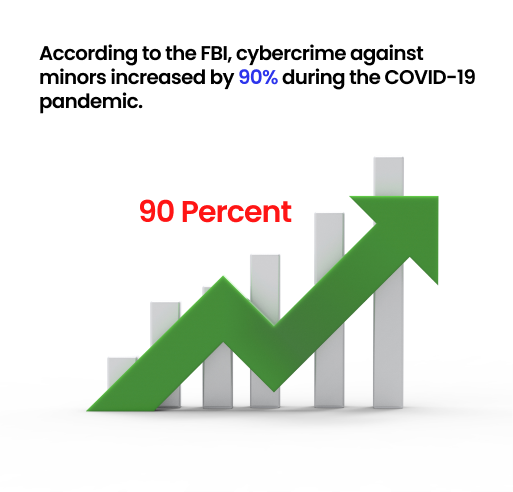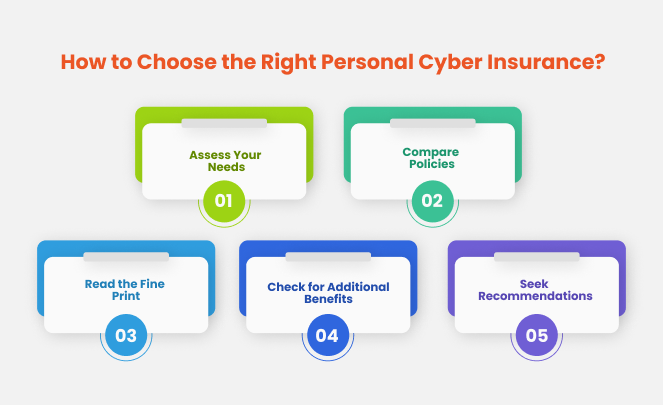“Cybersecurity is everyone’s responsibility.” Kids these days spend a lot of time online. From social media to gaming, the internet is a big part of their lives. But the internet isn’t always a safe place. Cyber threats are real and growing, and they can have serious consequences. That’s why parents need to step up and educate their children about these dangers. Plus, there’s something else that can help keep your family safe: personal cyber insurance. Let’s dive into why both are so important and how you can get started.
Why Parents Should Educate Their Kids About Cyber Threats
Why It’s Important

Cyber threats are everywhere, and kids are often easy targets. According to the FBI, cybercrime against minors increased by 90% during the COVID-19 pandemic. This statistic is alarming and highlights the urgent need for awareness and education. Here are some of the main threats:
- Cyberbullying: 37% of kids between 12 and 17 have been bullied online.
- Online Predators: 1 in 25 children has received an online sexual solicitation.
- Phishing Scams: There were over 241,000 reported phishing attacks in 2021, many targeting kids.
- Identity Theft: More than 1 million children were victims of identity theft in 2020, costing families nearly $1 billion.
How Parents Should Educate Their Kids About Cyber Threats?
1. Start the Conversation Early
It’s never too early to start talking to your kids about online safety. Use simple language and real-life examples to make the dangers relatable. For instance, explain how sharing personal information can be risky.
2. Set Clear Rules and Boundaries
Make sure your kids know the rules for using the internet. This includes which sites and apps they can use, how much time they can spend online, and what they should never share (like their full name, address, or school).
3. Teach Critical Thinking
Encourage your kids to think critically about what they see online. Teach them to spot phishing scams, avoid clicking on suspicious links, and never share personal information without checking with you first.
4. Use Parental Controls
Take advantage of parental control software to monitor your kids’ online activities. These tools can help block inappropriate content, track usage, and set time limits.
5. Encourage Open Communication
Make sure your kids feel comfortable coming to you with any problems they encounter online. Let them know they won’t get in trouble for telling you about something scary or uncomfortable.
6. Role-Playing Scenarios
Practice what-ifs with your kids. What if someone they don’t know messages them? What if a pop-up asks for their password? Role-playing these scenarios can help them know what to do in real life.
Real-life stories of cyber threats involving children
Here are some recent real-life stories of cyber threats involving children from 2022-2024, highlighting the importance of educating kids about online dangers and considering personal cyber insurance.
1. Sextortion Schemes
In 2022, there was a significant increase in sextortion schemes targeting minors, with over 3,000 reported victims. Sextortion involves predators coercing children into sending explicit images and then threatening to release these images unless more material or money is provided. These crimes often lead to severe psychological distress and have, tragically, resulted in several suicides (Justice).
2. Online Gaming Scams
A notable case in 2023 involved a 14-year-old boy who was scammed through an online gaming platform. The boy was tricked into sharing his parents’ credit card details by someone posing as a game administrator offering in-game perks. This led to unauthorized charges amounting to several thousand dollars. Such incidents highlight the need for parental vigilance and education about the dangers of sharing personal information online (Surfshark).
3. Phishing Attacks
In 2022, there was a 20% increase in phishing attacks targeting children. One high-profile case involved a 12-year-old girl who received a phishing email that appeared to be from a popular social media platform. She was lured into providing her login details, which were then used to post inappropriate content on her account, leading to severe cyberbullying and emotional distress (IC3).
4. Social Media Impersonation
In 2023, a teenager was targeted by cybercriminals who created fake social media profiles impersonating her friends. The criminals used these profiles to gain her trust and solicit personal information, which was then used to access her family’s financial accounts, resulting in substantial financial loss. This case underscores the importance of teaching children to verify the identities of their online contacts (Surfshark).
5. Data Breaches
In a 2022 incident, a major data breach at an educational technology company exposed the personal information of thousands of students, including names, addresses, and social security numbers. This breach led to multiple cases of identity theft among minors, with fraudulent credit accounts being opened in their names. The long-term implications of such breaches can be devastating, as many victims only discover the fraud years later when applying for student loans or other financial services (Singapore Police Force).
6. Crypto Investment Scams
A recent trend in 2023 saw teenagers being targeted by fake cryptocurrency investment schemes. Scammers used social media platforms to lure minors with promises of high returns. In one case, a 15-year-old boy invested his savings into a fake crypto platform, only to lose all his money. These scams are particularly dangerous as they exploit the financial naivety of young investors (Surfshark) (Singapore Police Force).
Why Is Personal Cyber Insurance Essential?
1. Financial Protection
Cyber insurance covers the costs if you fall victim to cybercrimes like identity theft or cyber extortion. This protection is crucial because the financial impact of cyberattacks can be huge.
2. Peace of Mind
Knowing you have a safety net can help you feel more secure. Cyber insurance provides support services like legal advice and identity restoration, so you’re not dealing with a cyberattack alone.
3. Comprehensive Coverage
Personal cyber insurance policies often cover a range of cyber threats, from cyberbullying to unauthorized credit card use. This comprehensive coverage ensures you’re protected against various risks.
4. Support Services
Many cyber insurance plans include additional support services. These can include cybersecurity training, monitoring services, and access to experts who can help you navigate cyber threats.
How to Choose the Right Personal Cyber Insurance?

1. Assess Your Needs
Think about your family’s online activities and potential risks. Consider how many devices you use, the types of online interactions you have, and how sensitive your information is.
2. Compare Policies
Research different cyber insurance policies to find the one that best fits your needs. Look for policies that offer comprehensive coverage, including protection against cyberbullying and identity theft.
3. Read the Fine Print
Make sure you understand what the policy covers and any exclusions. Pay attention to coverage limits, deductibles, and how to file a claim.
4. Check for Additional Benefits
Look for policies that offer extras like access to cybersecurity experts, monitoring services, and educational resources. These benefits can enhance your family’s overall protection.
5. Seek Recommendations
Talk to other parents, cybersecurity professionals, or insurance agents to get recommendations on the best cyber insurance policies for families.
Educating Parents About Cyber Threats
1. Stay Informed
Parents need to keep up with the latest cyber threats and trends. Follow reputable cybersecurity blogs, news outlets, and social media accounts to stay updated.
2. Attend Workshops and Webinars
Many organizations offer workshops and webinars on cybersecurity for parents. These events provide valuable insights and practical tips for protecting your family online.
3. Join Online Communities
Join online forums and communities where parents discuss cybersecurity issues and share experiences. These platforms can offer support, advice, and resources.
4. Leverage School Resources
Many schools provide resources and programs to educate parents about online safety. Take advantage of these offerings to enhance your knowledge and skills.
Implementing a Family Cybersecurity Plan
1. Conduct a Risk Assessment
Identify potential cyber threats and vulnerabilities in your family. Consider the types of devices used, online activities, and the sensitivity of the information shared.
2. Develop a Cybersecurity Policy
Create a family cybersecurity policy outlining rules and guidelines for online behavior, device usage, and data protection. Make sure all family members understand and follow the policy.
3. Regularly Update Software and Devices
Keep all software and devices updated with the latest security patches. This helps protect against known vulnerabilities.
4. Use Strong, Unique Passwords
Ensure everyone uses strong, unique passwords for their online accounts. Encourage the use of password managers to store and generate secure passwords.
5. Enable Two-Factor Authentication
Enable two-factor authentication (2FA) for online accounts whenever possible. 2FA adds an extra layer of security by requiring a second form of verification.
6. Regularly Back Up Data
Regularly backup important data to an external hard drive or cloud storage service. This ensures you can recover your data in case of a cyberattack.
7. Monitor Online Activities
Keep an eye on your kids’ online activities and maintain open communication. Use parental control software to help manage and track their digital interactions.
The Role of Schools in Cybersecurity Education
1. Integrating Cybersecurity into the Curriculum
Schools should teach students about online safety, digital citizenship, and responsible use of technology as part of their curriculum.
2. Hosting Cyber Security Workshops
Schools can host cybersecurity workshops for students and parents, providing practical tips and resources for protecting against cyber threats.
3. Collaborating with Experts
Schools can work with cybersecurity experts and organizations to provide up-to-date information and training on emerging threats and best practices.
4. Providing Resources
Schools should offer resources like brochures, websites, and helplines to help students and parents navigate cybersecurity issues.
5. Encouraging Safe Online Practices
Schools should promote safe online practices, such as using strong passwords, enabling privacy settings, and recognizing phishing attempts.
The Future of Cybersecurity Education
1. Increasing Awareness
As cyber threats continue to evolve, it’s crucial to increase awareness about cybersecurity. Parents, educators, and policymakers must work together to ensure kids have the knowledge and skills to stay safe online.
2. Developing Comprehensive Programs
Comprehensive cybersecurity education programs should cover a wide range of topics, from basic online safety to advanced threat detection. These programs will prepare kids for the digital world.
3. Leveraging Technology
Technology can enhance cybersecurity education. Interactive apps, online courses, and virtual simulations can provide engaging and effective learning experiences.
4. Promoting Collaboration
Families, schools, and communities must collaborate to create a safe online environment for kids. Sharing knowledge, resources, and best practices can help build a collective defense against cyber threats.
Protecting Your Family with Mitigata: Personal Cyber Insurance

Teaching your kids about cyber threats is essential, but even the best precautions can’t eliminate all risks. That’s why investing in personal cyber insurance is crucial. Mitigata Personal Cyber Insurance offers comprehensive coverage to protect your family from the financial and emotional toll of cyberattacks.
With Mitigata, you can rest easy knowing that your loved ones are safeguarded against cyberbullying, identity theft, and other online threats.
Also Read: Cyber Insurance: Why Every Online Shopper Needs Personal Coverage.




